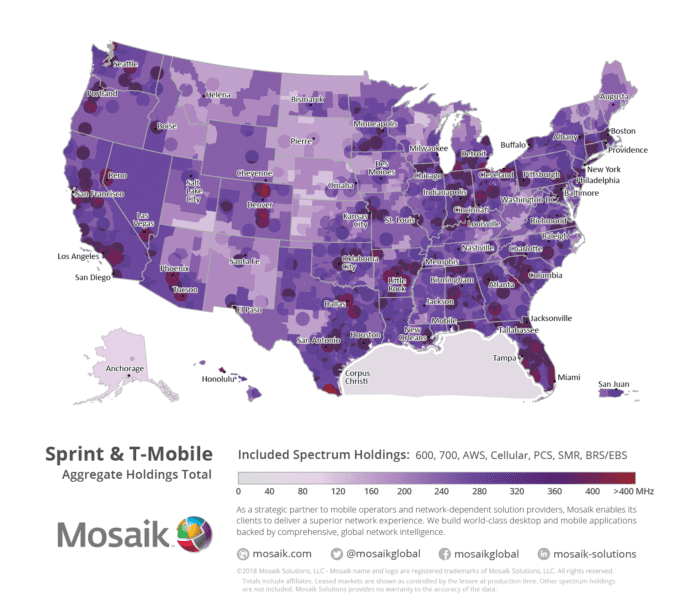This exclusive spectrum map from Mosaik illustrates the depth of spectrum holdings that would be in the possession of a new T-Mobile US if its proposed merger with Sprint is approved. The $146 billion transaction values Sprint at $59 billion.
In some areas of the country, the combined company would hold more than 400 MHz of spectrum across its bands. It would have particularly deep holdings in major metro areas including Los Angeles and San Diego, California; Columbia, South Carolina; Reno and Las Vegas, Nevada; Phoenix and Tucson, Arizona; Atlanta, Georgia; and Texas’ major metro areas. The combined carrier would also have a particularly deep spectrum position across large swaths of Florida, Ohio, Indiana, Massachusetts, Texas, Alabama, Colorado, California, South Carolina and Georgia.

The Mosaik map reflects a combined Sprint and T-Mobile US’ spectrum holdings including the Educational Broadband Service (EBS) and Broadband Radio Service (BRS) spectrum (recognizable by 35-mile-radius, circular geographic service areas) in the 2.5 GHz as well as in 600 MHz, 700 MHz, AWS, cellular, PCS and SMR.
John Gilmer, VP of geospatial data and analytics at Mosaik, said in an email exchange with RCR Wireless News that Sprint’s 2.5 GHz EBS/BRS holdings “add a significant amount to Sprint’s spectrum position. When combined with T-Mobile’s holdings, it gives the merged entity an extremely broad and deep spectrum position, with the 600 band giving geographic reach and the 2.5 GHz adding capacity and bandwidth in population dense areas.”
In addition to the depth of the combined spectrum holdings, the nationwide range is notable, as T-Mobile US CEO John Legere has emphasized the potential of the combined company to compete head-to-head with wired broadband to offer choice in rural and underserved areas and outlined a goal of achieving nationwide speeds of 450 Mbps. Legere has said that he sees cord-cutting for internet services as the future, and that the combined company’s network capacity and speed will enable more customers to rely only on wireless connectivity as their household’s connection.
As the map shows, a merged company’s combined spectrum holdings would include more — and often, much more than — 150 MHz of spectrum across most of the U.S.: from the Northeast and Great Lakes region to the Southeast and Gulf Coast, up and down the West Coast and much of the Mountain West. The company’s lightest footprint spectrum footprint would be in the Great Plains area and some parts of the Southwest.
Editor’s note: This story has been updated to reflect an updated map.

